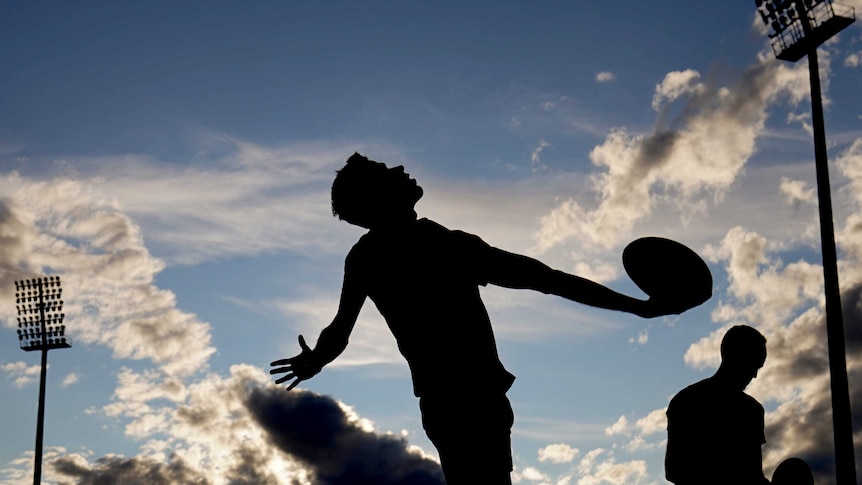Samantha Donovan: The Australian Football League has today made a controversial call to scrap a tradition of the men’s game that’s well over a century old. Starting next season the umpire will no longer start games and passages of play with a centre bounce. Instead the footy will be thrown into the air as is done in most other leagues. The AFL says the decision will bring more umpires to the game and cut the number of injuries they suffer but footy veterans and fans have divided opinions on the rule change. Kimberley Price filed this story.
AFL commentary: Opening bounce of the grand final. Ottens climbs into Brogan. Brogan hits his hand.
Kimberley Price: It’s a hallmark of Australian rules football. The umpire stands in the middle of the oval, slams the ball into the ground and hopefully it bounces straight up into the air so that two players can compete for it.
AFL commentary: It is grand final day and here’s the first bounce and there’s a mighty roar.
Kimberley Price: It’s considered one of the game’s great spectacles but sometimes that bounce doesn’t go to plan. Now the AFL has called it quits on the umpire’s centre bounce, a tradition stretching back well over a century. The prospect of this change has for years been hotly debated. On the streets of Melbourne fans have strong views on whether the bounce should stay or go.
AFL fans: Disgusted. Disgusted is the tradition of the game like it’s been around for 150 years.
AFL fans: I think it’s a really good idea. It means more umpires will be able to umpire or get into umpiring and continue on with umpiring.
AFL fans: I love the chaos of the centre bounce. You never know which direction it’s going to go in so I say keep the bounce. Get rid of it.
AFL fans: Because it slows the game down a bit like it feels really tight at the end.
AFL fans: It’d be nice if they could bounce it properly. I mean I’ve never had to do it so it must be a hard thing.
Kimberley Price: The centre bounce was introduced into the men’s game in 1887 to start each quarter and four years later it was also introduced to start play after a goal was scored. But from next year the football will instead be thrown into the air. It’s already happening around other parts of the ground when the umpire calls for what’s called a ball up and it’ll mirror the current rules in the AFL women’s competition. AFL executive football manager Greg Swann says the decision will ease the physical pressure on umpires.
Greg Swann: It’s primarily around the pathways and the safety of the umpire. So in a pathway sense all the competitions in Australia that no one bounces the ball. You know that’s a skill you have to put a fair bit of time into practice and what we’d rather do is have the umpires putting their skills into the making the correct decisions.
Kimberley Price: Umpire Ray ‘Razor’ Chamberlain has over 20 years experience of executing the centre bounce.
Ray Chamberlain : Wasn’t something I was renowned for being brilliant at and it caused me a truckload of anxiety but I love the bounce in the game.
Kimberley Price: The AFL believes canning the bounce will help bring more umpires to the game, something Razor agrees with.
Ray Chamberlain : But all junior levels and grassroots level they don’t bounce the ball. When you get into umpiring and you start umpiring you’re not practicing it you’re only required to try and do it if you’re considered to be an elite pathways umpire and there’d be less than 150 people outside of the AFL who bounce the ball in the country as it is today.
Kimberley Price: Another reason the AFL has put an end to the bounce is the injury risk it poses to umpires.
Scott Starkey: There’s clearly significant muscular demands going on.
Kimberley Price: That’s Dr Scott Starkey a physiotherapist by trade and biomechanist at the University of Melbourne.
Scott Starkey: So if we think about the force we’re generating through the shoulder muscles, lats, deltoids, maybe pectorals as well, to be driving that ball down into the ground a huge amount of force is required.
Kimberley Price: He says the motion of the bounce can affect an umpire’s whole body.
Scott Starkey: The momentum that you’re generating so that includes your quads, hip flexors, glutes, hamstrings and perhaps most importantly your abdominals, your rectus abdominis. So your base is parallel with stomach to the ground and when your spine is in that bent position you’re actually at increased risk of disc related injuries.
Kimberley Price: In another rule change announced today the AFL has ditched the substitute rule and has instead extended the bench from four players to five.
Samantha Donovan: Kimberley Price with that report.

